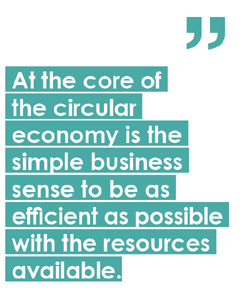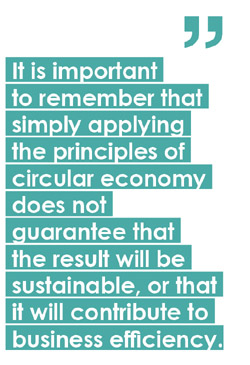On the other hand, the principles of circular economy introduce a closed loop cycle. This process is meant to be regenerative by design. This can be done by strategies for optimizing the usage of resources, maximizing the lifespan and usage of products, and recovery and reuse of byproducts and waste.
 Circular economy principles may be driven by environmental concerns, and the aim to minimize the negative impacts on the environment from harmful waste- damaging due to volume, toxicity, or sheer impracticality. However at the core of the circular economy is the simple business sense to be as efficient as possible with the resources available. Whenever a process produces waste or byproducts, these represent the value that is trapped and unused - and it makes business sense to extract and utilize as much of this trapped value as possible.
Circular economy principles may be driven by environmental concerns, and the aim to minimize the negative impacts on the environment from harmful waste- damaging due to volume, toxicity, or sheer impracticality. However at the core of the circular economy is the simple business sense to be as efficient as possible with the resources available. Whenever a process produces waste or byproducts, these represent the value that is trapped and unused - and it makes business sense to extract and utilize as much of this trapped value as possible.
Many businesses do realize that going circular creates a significant competitive advantage. Differentiation of product offerings may produce ideas that are better in line with shifting customer demands, adding new revenue streams. A process designed to optimize resource use and recover spent material will decrease raw material costs. And on a larger scale: unlocking the trapped value in the value chains will increase overall GDP growth and create new job opportunities in engineering, reverse logistics, and R&D.
Sounds very optimistic and straightforward. But there’s a catch. I’m sure we’ve all been in a situation where we were more efficient than expected, or saved money, or time. How difficult is it to use this new resource efficiently? If we spend the saved resources on something else equally inefficient, is it even worth saving them in the first place?
It is important to remember that simply applying the principles of circular economy does not guarantee that the result will be sustainable, or that it will contribute to business efficiency. This is called the “rebound effect” - it doesn’t make any sense to save on electricity only to light up ten new billboards with the savings. Repairing products doesn’t make sense if we use the saved money to purchase additional products that will turn to waste. Implementing circular strategies may not lead to overall increase in efficiency, even when these strategies work flawlessly and achieve their set objectives in terms of saving energy, prolonging product lifespan, and reducing waste.

Businesses may only see true value materialize from circular strategies when these strategies are not planned in isolation, but holistically, taking into consideration the whole enterprise. Therefore an important part of any sensible circular strategy must be to plan the efficient utilization of the value that is unlocked and has been previously trapped in the value chain.
Saving resources in one department cannot lead to another just balancing the equation.
Economic theory comes into play here - avoiding rebound may be less successful if circular strategies produce secondary products which cannot compete with primary alternatives. If we plan to use the saved resources in a specific way, it is important for a circular strategy to have no impact on the overall demand of a product. Otherwise we will simply end up producing more, but for example miss the target of investing in research. These effects should be examined in detail before choosing a sensible and efficient circular strategy to truly bring value to a business and have a meaningful effect.
So that next time when we save on chocolate ice cream, we don’t use the euro saved to buy vanilla, but instead a good book in a secondhand bookshop.
Marek Frecer, Senior Manager, PwC



Follow us